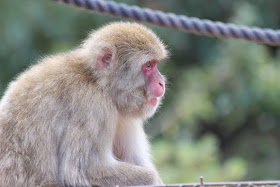For
people who like monkeys, Japan Kyoto
The
park operates on a very simple concept: “If you feed them, they will come.” According to the park’s home page, there are
about 120 macaques that live in the park.
Although they are free to come and go into the surrounding hills and
forest, they are bound to the park by the promise of an easy meal. Using loud shouts of “Oi!” and circus-tempo
music over loudspeakers, the park staff signal to the macaques that feed grain and
peanuts will immediately be spread in the clearing in front of the rest house
built on the top of the hill. This
feeding time has been somewhat engineered into a show-like event for the sake
of tourists, and judging by comments posted on word-of-mouth web-sites, it is quite
popular.
An Animal Encounter
of the Reverse Kind: Monkeys outside, Humans inside the cage
There are four simple rules printed
in English on the oversized admission ticket: “don’t stare monkeys in the eye”,
“don’t touch the monkeys”, “don’t feed them outside”, and “don’t take a picture
on the way”. With respect to the first
two rules, although the macaques don’t seem to be 100% wild, they are certainly
not tame, so staring at them and touching them may trigger an attack. The third rule refers to the fact that
visitors may feed the animals from inside the rest house which has large wire
screen windows. Small packages of banana
slices, apple chunks, and peanuts still in the shell are available for 100 yen,
and visitors are instructed to offer the treats with an open palm, allowing the
macaques to reach through the wire screen and pick up the food gently. Visitors are warned to not show the macaques
any food while outside of the rest house.
If the macaques even think you have food in your bags or packages, they
may grab the bag and carry it off into the hills.
The
fourth rule regarding not taking pictures “on the way” appears to refer to photographs
taken while walking up the path to the top of the hill. This rule is probably to prevent visitors
from staring at the macaques in those areas where there aren’t any park staff
members to back the macaques down if they get too aggressive. For the most part, if you walk slowly around
the park and act disinterested, or better yet, if you sit somewhere, the
macaques will most likely act as if you are not there and end up right in front
of your camera lens.
After
sitting or walking among the seemingly peaceful macaques for awhile, the
idyllic atmosphere might lull some visitors into a false sense of safety. Many people seem to forget that the macaques
are wild animals and not pets. I get a
bit nervous when I see young couples allow their small children (about 2 or 3
years old) to toddle around within 1 or 2 meters of the macaques. While the macaques generally ignore these human
intruders, if there were an attack, the parents would most likely not be able
to scoop up their children before some serious injury was inflicted.
Various Expressions
and Personalities
According
to the park home page, all of the macaques in the park have been given
names. They apparently can be recognized
by face and by their distinct personalities. Here are a few interesting faces:
The
video below was recorded on September 13, 2014.
Educational Efforts
On the trail leading up the
hill there were a number of signs, some in Japanese, some in English, providing
a few simple facts about the macaques. There were no signs at the top of the hill.
With
respect to the interior of the rest house, I thought that it was a missed
opportunity. There were a few photographs
of some of the macaques, but I did not notice any explanatory displays or
printed materials. Since most visitors
to the park enter the rest house at least for a little while, it would have
been a good place to arrange some type of educational display. On the day of my visit, I noticed about 5
park staff, and I like to think that they often answer visitor questions about
the macaques and their lifestyle, but I did not notice any such conversations
while I was there.
Food and Souvenirs
There
were soft drinks sold in the rest house and also near the ticket booth and
entrance at the base of the hill. In
terms of souvenirs, there was a limited selection of straps, postcards,
refrigerator magnets, and other small items.
Getting
There
The
nearest train station is Hankyu Railways’ “Arashiyama” station. From there, it is about an 8-minute walk to the
entrance of the park. Just walk upriver
along the south bank of the river (the left-hand side as you walk upriver)
until you pass the Togetsu
Bridge
(Note:
All photos taken in this post were taken during a visit on September 13, 2014. The comments in this post are based on
observations made on that day.
Conditions may have since changed.
Please check it out for yourself!)

















































